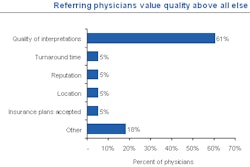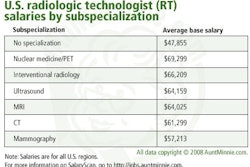It's always good news when protocol gets simplified, and for radiology administrators this is particularly true for outpatient procedures. This fall, the Joint Commission of Oak Brook, IL, the independent, nonprofit body that accredits and certifies 15,000 healthcare organizations and programs in the U.S., will unveil restructured ambulatory standards that will be available in 2009.
Starting in 2006, the Joint Commission undertook extensive data gathering from the field, using Web-based field surveys and surveyor questionnaires and engaging with accredited and unaccredited clients, payors and purchasers, and professional organizations. The organization hopes that what it found from these interviews -- and the changes it has made as a result of them -- will help radiology administrators stay up-to-date more easily.
Michael Kulczycki, executive director of the ambulatory care accreditation program, and Dee Murphy, field representative, presented an overview of the coming changes at the 2008 American Healthcare Radiology Administrators (AHRA) conference in Denver.
Not new, just improved
Changes to the Joint Commission's ambulatory protocol encompass the structure of the standards, the language used in the manual and manual formats, and scoring. But Kulczycki took care to stress that the Joint Commission has not added any new standards to its ambulatory care accreditation protocol; rather, it has focused on making existing requirements easier to understand and find in the manual.
"We've addressed the structure of our manual and the wording, trying to get rid of 'Joint Commission-ese,' " Kulczycki said. "Hopefully the manual reads more like a novel now, so everyone can understand the story."
The manual's current nine chapters have been revised, and five new chapters have been created to reorganize existing information.
Existing chapters:
- Ethics, Rights, and Responsibilities
- Improving Organization Performance
- Leadership
- Management of Information
- Management of Human Resources
- Management of Environment of Care
- Medication Management
- Prevention and Control of Infection
- Provision of Care
New chapters:
- Emergency Management
- Life Safety Code
- Record of Care, Treatment, and Services
- Tissue Transplant Safety
- Waived Testing
Joint Commission customers can view a PDF version of the new manual now, Murphy said. The standards manual will be available in September and a Web-based edition will be available in November. In January 2009, the completely revised Standards Compliance manual will be distributed.
The comprehensive accreditation manuals will be available in a variety of formats, including a 6 by 9-inch binder (free to all Joint Commission clients), as well as an optional 9 by 12-inch binder version. They will include comparison tables that show the current standard and where it can be found in the reorganized standards.
The electronic edition will include features such as history tracking, search, and bookmarks for frequently used standards. For those who would like niche standards-only books, the Joint Commission will offer 6 by 9-inch standards-only books on particular topics, including diagnostic imaging.
How will the standards appear? Kulczycki and Murphy offered some examples of clarified and consolidated standards. ("EP" means "elements of performance.")
Clarified standard
|
Consolidated standard
|
Updated scoring and decision processes
"Our goals for refining the scoring and decision process were the standards compliance scoring and the accreditation decision should be valid reflections of an organization's performance and easily understood by all involved," Kulczycki said. "The process should be transparent, with all components fully disclosed."
To that end, the Joint Commission plans to eliminate the use of category B scoring characteristics. Category A will cover whether a facility is compliant with accreditation standards or not; category C will provide a way to outline multiple observations of noncompliance.
The onsite survey report will now be called "Summary of Survey Findings," Murphy said. It will be sorted by chapter and will include standards and elements of performance that are less than fully compliant.
"The new summary of survey findings will not include a potential accreditation decision," Murphy said. "That decision will be communicated in an official version of the report which will be posted to the organization's extranet site."
Finally, rather than a 30-day turnaround time to correct noncompliance, the Joint Commission plans to allow 45 days for direct impact standards and 60 days for indirect impact standards, Murphy said.
By Kate Madden Yee
AuntMinnie.com staff writer
August 14, 2008
Related Reading
CMS to raise hospital outpatient payments 3%, July 8, 2008
Outpatient imaging: Back to the hospital? October 5, 2007
Preparing for a JCAHO visit, April 18, 2006
Copyright © 2008 AuntMinnie.com



















